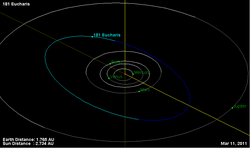Astronomy:181 Eucharis
 Orbital diagram | |
| Discovery | |
|---|---|
| Discovered by | Pablo Cottenot |
| Discovery date | 2 February 1878 |
| Designations | |
| (181) Eucharis | |
| Pronunciation | /ˈjuːkərɪs/[1] |
| Named after | Eucharis |
| A878 CB; 1906 GA | |
| Minor planet category | Main belt |
| Orbital characteristics[2] | |
| Epoch 31 July 2016 (JD 2457600.5) | |
| Uncertainty parameter 0 | |
| Observation arc | 123.63 yr (45157 d) |
| |{{{apsis}}}|helion}} | 3.7664 astronomical unit|AU (563.45 Gm) |
| |{{{apsis}}}|helion}} | 2.49280 AU (372.918 Gm) |
| 3.12958 AU (468.179 Gm) | |
| Eccentricity | 0.20347 |
| Orbital period | 5.54 yr (2022.2 d) |
| Average Orbital speed | 16.64 km/s |
| Mean anomaly | 32.3207° |
| Mean motion | 0° 10m 40.879s / day |
| Inclination | 18.890° |
| Longitude of ascending node | 143.224° |
| 318.943° | |
| Earth MOID | 1.53686 AU (229.911 Gm) |
| Jupiter MOID | 1.47086 AU (220.038 Gm) |
| TJupiter | 3.099 |
| Physical characteristics | |
| Dimensions | 106.66±2.2 km |
| Rotation period | 52.23 h (2.176 d)[2][3] |
| Geometric albedo | 0.1135±0.0054 |
| S (Tholen) Xk (Bus)[4] | |
| Absolute magnitude (H) | 7.84 |
Eucharis (minor planet designation: 181 Eucharis) is a large, slowly rotating main-belt asteroid that was discovered by France astronomer Pablo Cottenot on February 2, 1878, from Marseille Observatory.[5] It was his only asteroid discovery. This object was named after Eucharis, a nymph from the 17th-century novel Les Aventures de Télémaque.
In the Tholen classification system, it is categorized as a stony S-type asteroid, while the Bus asteroid taxonomy system lists it as an Xk asteroid.[4] Photometric observations of this asteroid at the Goat Mountain Astronomical Research Station in Rancho Cucamonga, California during 2007 gave a light curve with a leisurely rotation period of 52.23 ± 0.05 hours.[3]
This object is the namesake of a family of 149–778 asteroids that share similar spectral properties and orbital elements; hence they may have arisen from the same collisional event. All members have a relatively high orbital inclination.[6]
References
- ↑ eucharis (3rd ed.), Oxford University Press, September 2005, http://oed.com/search?searchType=dictionary&q=eucharis (Subscription or UK public library membership required.)
- ↑ 2.0 2.1 Yeomans, Donald K., "181 Eucharis", JPL Small-Body Database Browser (NASA Jet Propulsion Laboratory), https://ssd.jpl.nasa.gov/sbdb.cgi?sstr=181, retrieved 12 May 2016.
- ↑ 3.0 3.1 Stephens, Robert D. (March 2008), "Long Period Asteroids Observed from GMARS and Santana Observatories", The Minor Planet Bulletin 35 (1): pp. 21–22, Bibcode: 2008MPBu...35...21S.
- ↑ 4.0 4.1 DeMeo, Francesca E. et al. (July 2009), "An extension of the Bus asteroid taxonomy into the near-infrared", Icarus 202 (1): pp. 160–180, doi:10.1016/j.icarus.2009.02.005, Bibcode: 2009Icar..202..160D, archived from the original on 2014-03-17, https://web.archive.org/web/20140317200310/https://www.tara.tcd.ie/bitstream/2262/43276/1/PEER_stage2_10.1016/j.icarus.2009.02.005.pdf, retrieved 2013-04-08. See appendix A.
- ↑ "Numbered Minor Planets 1–5000", Discovery Circumstances (IAU Minor Planet center), https://www.minorplanetcenter.net/iau/lists/NumberedMPs000001.html, retrieved 2013-04-07.
- ↑ Novaković, Bojan et al. (November 2011), "Families among high-inclination asteroids", Icarus 216 (1): pp. 69–81, doi:10.1016/j.icarus.2011.08.016, Bibcode: 2011Icar..216...69N.
External links
- 181 Eucharis at AstDyS-2, Asteroids—Dynamic Site
- 181 Eucharis at the JPL Small-Body Database
 |

